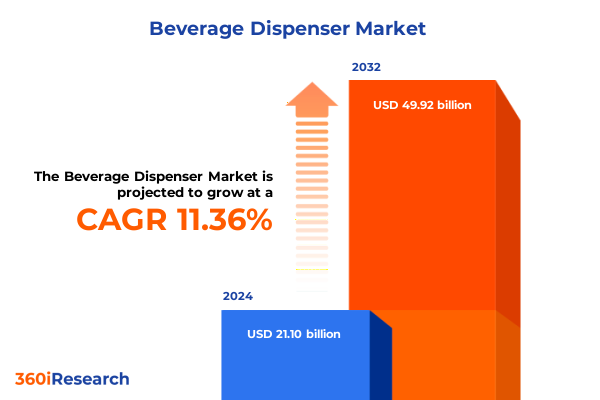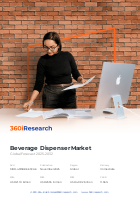The Beverage Dispenser Market size was estimated at USD 21.10 billion in 2024 and expected to reach USD 23.35 billion in 2025, at a CAGR of 11.36% to reach USD 49.92 billion by 2032.

Innovative Solutions and Consumer Trends Driving Rapid Evolution in the Beverage Dispenser Industry on a Global Scale Under Complex Market Pressures
The beverage dispenser industry is at a critical inflection point, driven by surging consumer demand for convenience, hygiene, and customization. Innovations ranging from touchless dispensing to integrated IoT-enabled monitoring are redefining what end users expect from coffee, juice, soda, tea, and water dispensers. Meanwhile, rising environmental concerns are prompting manufacturers to explore eco-friendly materials and energy-efficient designs to meet stricter sustainability standards.
Against this backdrop, businesses in the foodservice and residential appliance sectors are racing to adapt, investing in next-generation platforms that deliver both operational efficiency and enhanced user experience. As market dynamics continue to shift, understanding the complex interplay of emerging technologies, regulatory pressures, and evolving distribution models is essential for stakeholders seeking to capture growth opportunities in this highly competitive landscape.
How Technological Advancements, Sustainability Mandates, and Changing Consumer Habits are Reshaping the Beverage Dispenser Landscape Worldwide
In recent years, the beverage dispenser market has undergone transformative shifts as industry players embrace digitalization and sustainability. Advanced sensors and cloud connectivity now enable real-time monitoring of usage data and predictive maintenance alerts, reducing downtime and optimizing service schedules. Simultaneously, the proliferation of contactless interfaces has addressed heightened hygiene requirements, a trend accelerated by global health concerns.
Embracing circular economy principles, forward-thinking manufacturers are incorporating recyclable plastics and biodegradable components into dispenser designs. This shift not only mitigates environmental impact but also resonates with eco-conscious consumers. Moreover, the blending of modular architectures with user-friendly interfaces is empowering operators to offer highly customizable beverage experiences-from precision-brewed cold brew coffee to multi-flavor soda dispensing-at scale across commercial and residential settings.
Assessing the Cumulative Impact of United States Tariff Measures in 2025 on the Beverage Dispenser Supply Chain and Cost Structures
Since 2018, U.S. trade policy has significantly altered the cost structure and supply chain dynamics for equipment importers, culminating in an average U.S. import tariff rate rising from just above 2% to approximately 15%, the highest level since the 1940s. These tariff escalations encompass a broad array of appliance components, including plastics, electronics, and metals essential for beverage dispenser manufacture, placing upward pressure on input costs and, in many cases, prompting redirection of sourcing strategies away from traditional hubs.
Layered on top of base Most Favored Nation rates, Section 301 duties on goods sourced from China continue to range from 7.5% to 25%, with some segments-particularly electronic controllers and specialized pump assemblies-subject to supplemental levies that have soared as high as 145%. While temporary exclusions have been periodically extended, these measures remain in force through mid-2025, reinforcing the need for supply chain resiliency and diversified tariff planning among industry participants.
In a landmark development, a 90-day reciprocal tariff reduction agreement enacted on May 14, 2025, lowered the “reciprocal” duty on Chinese-origin materials from 125% to 10% and mirrored reductions on U.S. exports. However, this adjustment did not alter existing Section 301 or product-specific duties, underscoring the continued importance of tariff classification expertise. As a result, many manufacturers are evaluating nearshoring options and dual sourcing frameworks to hedge against future policy volatility and maintain cost competitiveness.
Key Insights into Product Types, Technologies, End Users, Distribution Channels, and Capacities Defining the Beverage Dispenser Market Segmentation
The beverage dispenser market exhibits a rich tapestry of product types, spanning coffee, juice, soda, tea, and water dispensing systems, each tailored to distinct consumption occasions and operator requirements. Technology variations such as fully automatic units that leverage robotics for consistent pour volumes, semi-automatic machines that blend user control with mechanized processes, and manual dispensers appealing to cost-sensitive buyers create multiple pathways for innovation and differentiation.
End users range from high-traffic commercial venues requiring robust, high-capacity solutions to residential consumers seeking compact, aesthetically pleasing units for at-home convenience. Distribution channels further diversify the ecosystem, with retail and specialty stores providing hands-on demonstrations and direct interaction, while online platforms-from manufacturer websites to established marketplaces and e-retailers-cater to the growing preference for digital procurement. Capacity offerings spanning smaller vessels up to 20 liters, mid-range options between 20 and 50 liters, and large systems exceeding 50 liters ensure that applications from boutique cafes to large-scale institutional settings are comprehensively served.
This comprehensive research report categorizes the Beverage Dispenser market into clearly defined segments, providing a detailed analysis of emerging trends and precise revenue forecasts to support strategic decision-making.
- Product Type
- Technology
- Capacity
- Distribution Channel
- End User
Examining Critical Regional Dynamics Across the Americas, Europe Middle East and Africa, and Asia-Pacific Driving Beverage Dispenser Market Evolution
Across the Americas, market evolution is driven by the United States and Canada, where quick-service restaurants and corporate offices prioritize high-throughput, hygienic dispensing solutions. Investment in contactless beverage delivery and integrated analytics tools is particularly pronounced, with a marked shift toward on-premise customization and subscription-based service models in major metropolitan areas.
In Europe, the Middle East, and Africa, adoption patterns reflect diverse consumer habits and regulatory landscapes. Stringent energy efficiency regulations in Western Europe have catalyzed innovation in low-power consumption units, while growth in the hospitality sector across the Middle East is fueling demand for premium, digitally managed dispenser systems. Africa’s emerging markets are witnessing gradual uptake, with commercial enterprises balancing affordability with reliability.
The Asia-Pacific region stands out for its rapid expansion, underpinned by booming coffee culture in China and India, a proliferation of modern office environments, and rising disposable incomes. Here, both commercial and residential segments are embracing IoT-enabled devices, with localized value-added services-such as remote troubleshooting and warranty extension programs-taking center stage to support widespread deployment.
This comprehensive research report examines key regions that drive the evolution of the Beverage Dispenser market, offering deep insights into regional trends, growth factors, and industry developments that are influencing market performance.
- Americas
- Europe, Middle East & Africa
- Asia-Pacific
Strategic Profiles and Performance Highlights of Leading Global Manufacturers and Innovators in the Beverage Dispenser Industry
Market leadership is shaped by a mix of global and regional players focusing on differentiated innovation, robust service networks, and strategic partnerships. Leading equipment manufacturers have invested heavily in research and development, introducing proprietary connectivity platforms that integrate with operator dashboards to streamline maintenance workflows and predict component replacement cycles.
Strategic acquisitions and alliances have enabled these companies to broaden their technological portfolios, often adding specialized carbonation modules, precision-temperature controls, and advanced filtration systems. Meanwhile, emerging challengers are carving out niches by offering modular, cloud-native dispensers designed for seamless integration with third-party IoT frameworks and loyalty-program ecosystems, reflecting the critical importance of interoperability in this rapidly converging market.
This comprehensive research report delivers an in-depth overview of the principal market players in the Beverage Dispenser market, evaluating their market share, strategic initiatives, and competitive positioning to illuminate the factors shaping the competitive landscape.
- BUNN-O-MATIC Corporation
- BWT AG
- Coca-Cola HBC AG
- Cornelius Inc.
- Culligan International Company
- Follett Products, LLC
- Grindmaster-Cecilware
- Hoshizaki America, Inc.
- Keurig Dr Pepper Inc.
- Lancer Corporation
- Manitowoc Beverage Systems
- Nestlé S.A.
- PepsiCo, Inc.
- Primo Water Corporation
- The Coca-Cola Company
Proactive Strategies and Best Practices Industry Leaders Can Implement to Capitalize on Growth Opportunities in the Beverage Dispenser Sector
To navigate complex regulatory pressures and accelerate time to market, industry leaders should prioritize establishing diversified manufacturing footprints, including nearshore and in-country assembly to mitigate tariff impacts. By leveraging agile product development cycles, companies can iterate on modular platform architectures that accommodate evolving consumer preferences while reducing the need for large capital expenditures on bespoke machinery.
Furthermore, forging early partnerships with digital payment providers and software developers enables a seamless customer experience, driving higher adoption rates in both commercial and residential channels. Investing in sustainability credentials-such as carbon footprint labeling and end-of-life recycling programs-will not only meet tightening regulations but also serve as a compelling differentiator. Finally, cultivating cross-functional talent with expertise in supply chain analytics, regulatory compliance, and digital marketing will be essential for sustaining growth and resilience.
Robust Research Methodology Combining Primary Interviews, Secondary Data Analysis, and Rigorous Validation to Ensure Comprehensive Market Intelligence
This analysis combines qualitative insights from over two dozen in-depth interviews with equipment manufacturers, packaging suppliers, industry associations, and end users, supplemented by rigorous secondary research from trade publications, government trade databases, and financial disclosures. Data points are triangulated through cross-validation techniques, ensuring consistency and reliability across diverse information sources.
Our methodology also incorporates a detailed review of regulatory filings, customs duty schedules, and tariff notices, providing a comprehensive view of policy impacts on cost structures. Market segmentation insights derive from a combination of shipment data analysis, consumption surveys, and channel-partner feedback. All findings undergo multi-stage validation, including expert panels and peer review, to guarantee a robust perspective for strategic decision-making.
This section provides a structured overview of the report, outlining key chapters and topics covered for easy reference in our Beverage Dispenser market comprehensive research report.
- Preface
- Research Methodology
- Executive Summary
- Market Overview
- Market Insights
- Cumulative Impact of United States Tariffs 2025
- Cumulative Impact of Artificial Intelligence 2025
- Beverage Dispenser Market, by Product Type
- Beverage Dispenser Market, by Technology
- Beverage Dispenser Market, by Capacity
- Beverage Dispenser Market, by Distribution Channel
- Beverage Dispenser Market, by End User
- Beverage Dispenser Market, by Region
- Beverage Dispenser Market, by Group
- Beverage Dispenser Market, by Country
- Competitive Landscape
- List of Figures [Total: 30]
- List of Tables [Total: 579 ]
Summarizing Critical Findings and Implications for Stakeholders Navigating the Complexities of the Beverage Dispenser Market
In synthesizing the latest technological advances, regulatory shifts, and evolving consumer expectations, this study underscores the critical need for agility and foresight in the beverage dispenser industry. Companies that successfully balance innovation with operational efficiency, while navigating tariff complexities and regional nuances, will be best positioned to capture emerging opportunities.
As global networks and digital ecosystems continue to converge, stakeholders must invest in scalable platforms, forge strategic alliances, and adopt proactive regulatory monitoring. This report provides a clear roadmap for leveraging segmentation insights and regional dynamics to inform product development, channel strategies, and risk management frameworks. By embracing these imperatives, market participants can secure sustainable growth and maintain competitive advantage in an increasingly dynamic environment.
Engage with Ketan Rohom to Secure Tailored Insights from the Latest Beverage Dispenser Market Research Report and Drive Strategic Decisions
To gain unparalleled clarity on the forces reshaping the beverage dispenser market-from evolving consumer expectations to shifting trade policies-connect with Ketan Rohom, Associate Director of Sales & Marketing. His expertise ensures you’ll receive tailored guidance on leveraging our comprehensive research to inform your strategic roadmap. Reach out now to secure exclusive access to the full market insights report and position your organization ahead of the curve tomorrow.

- How big is the Beverage Dispenser Market?
- What is the Beverage Dispenser Market growth?
- When do I get the report?
- In what format does this report get delivered to me?
- How long has 360iResearch been around?
- What if I have a question about your reports?
- Can I share this report with my team?
- Can I use your research in my presentation?




